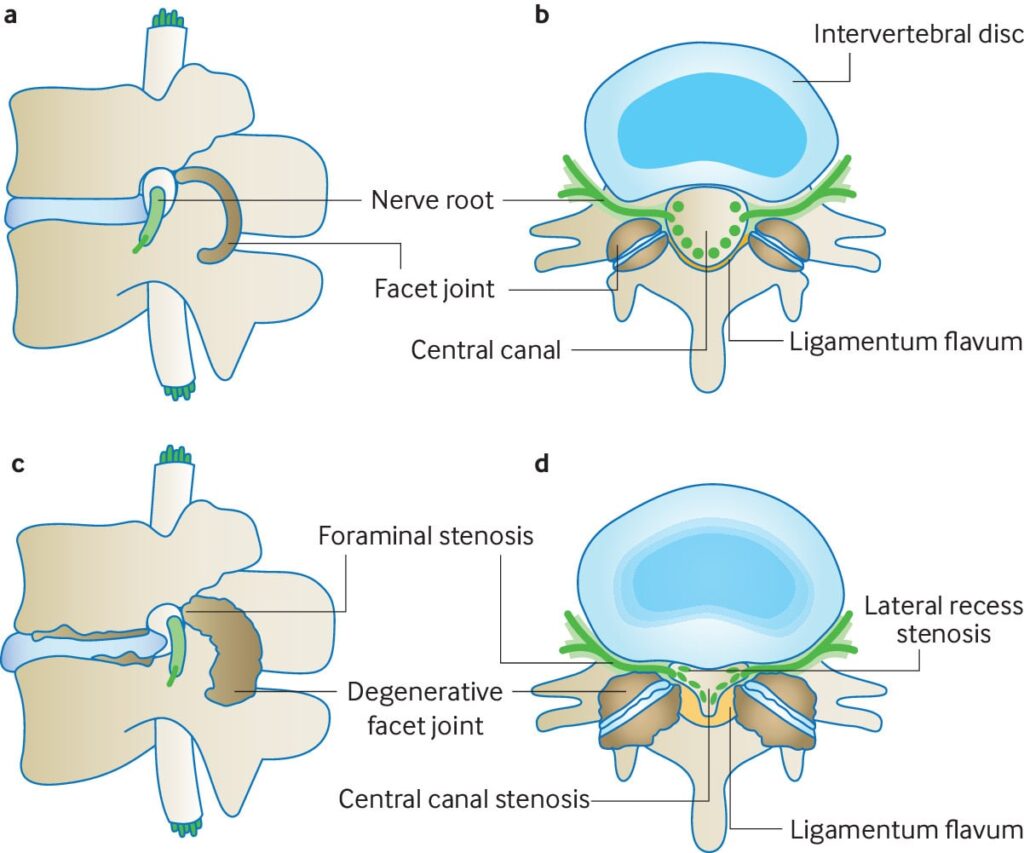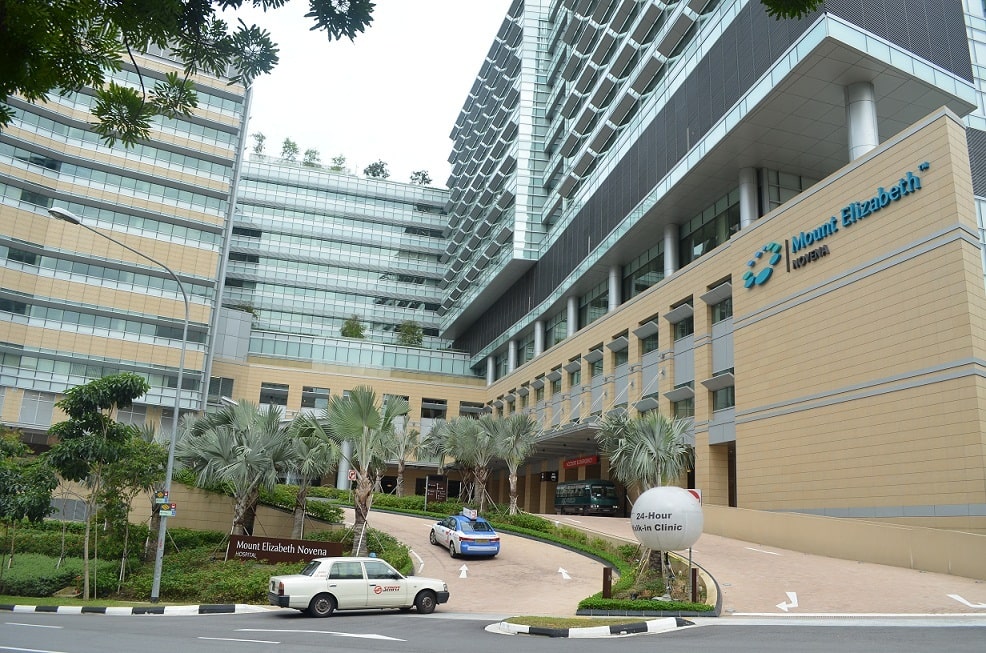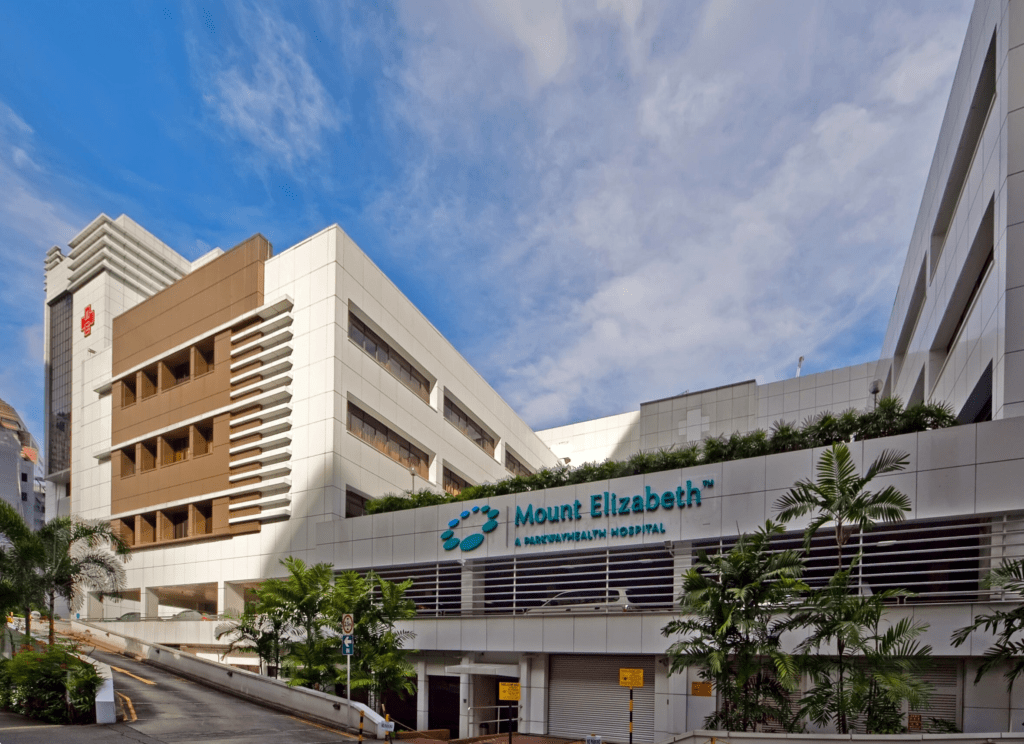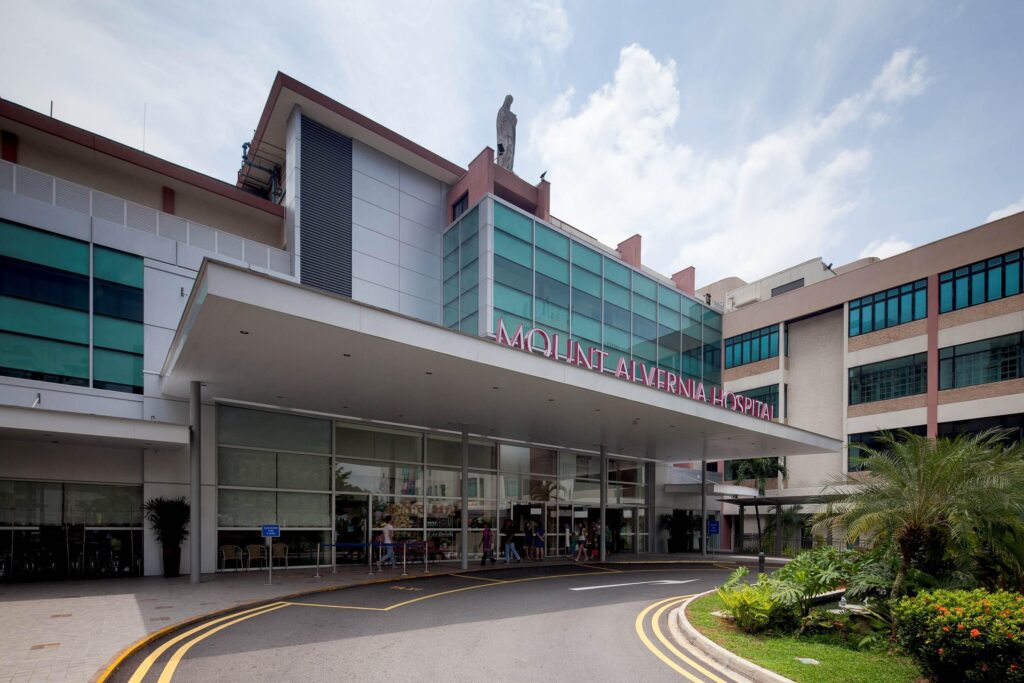Lumbar spinal stenosis is characterised by the narrowing of the lumbar spinal canal (the space around the spinal nerves) and compression of the nerves that travel through the spine and into the legs. This causes pain to radiate downwards to your feet as you walk. It may also cause weakness of numbness when you walk. Spinal stenosis can occur in any part of the spine, but is more common in the lower back (lumbar region).
It is a condition that occurs gradually over the years and hence, is often found to affect the middle-aged and elderly.
The lumbar spine is made up of five vertebrae (bones) along with accompanying intervertebral discs (‘cushions’ or ‘shock absorbers’) between the vertebrae. The discs consist of a soft jelly-like centre (nucleus) contained by a thick, tougher exterior (annulus). The joints between the bones are called facet joints and are lined with cartilage. Ligaments also connect the bones to each other. These structures allow the movement of the back and control stability and flexibility.

Lumbar spinal stenosis is found to be a result of many age-related changes such as
As we grow older, it is not uncommon for our spinal discs to degenerate and thin out and bulge. This disc bulging can contribute to spinal stenosis. Tears in the lining of the disc (annulus) can lead to herniation of the jelly-like soft centre (nucleus) which can compress the nerves.
The ligaments between the bones can stiffen over time and can bulge and become thickened which can also contribute to stenosis.
As part of the degenerative process changes can also occur in the facet joints. Overgrowth can occur (hypertrophy) and fluid collections (effusions) can occur in the joints. Sometimes the facet joint changes in association with the disc and ligament changes can lead to instability where one vertebra slips forward in relation to another (spondylolisthesis). This can worsen the stenosis.
The spine’s misguided effort to strengthen itself can cause tiny bone growths or bone spurs to form in response to natural wear-and-tear from osteoarthritis. These bone spurs can cause compression of the nerves also.

With spinal stenosis, one common symptom is pain in the legs or calves and lower back after walking. This pain is eased when sitting down or leaning over because more room is created for the spinal canal in these postures.
Not all patients will develop symptoms. It remains unknown why some patients are more susceptible to developing symptoms, while others are not.
The risk of spinal stenosis is greater in females aged 50 and older. Those born with a narrow spinal canal or have had previous injury to the spine are also more likely to suffer from this condition.
Although spinal stenosis is usually clinically diagnosed based on history taking and physical examination, the symptoms can mimic other conditions so a proper assessment is important. Imaging studies such as X-rays and MRI scans are typically used to investigate further. An MRI, in particular, would be useful to determine the nature and extent of the spinal stenosis. X-rays show the bony outline and the alignment of the bones in the back and MRI scan will be able to visualise the structures in your spine such as the discs, ligaments, joints, muscles and the spinal cord and the nerves. In some cases a CT scan is also done to assess the bony structures in more detail and to look at the extent of any bone spurs.
In the absence of progressive neurological symptoms, spinal stenosis can be managed initially through non-surgical methods such as physical therapy and medications (anti-inflammatory medications or painkillers). You may be encouraged to try selected aerobic activities such as swimming or stationary cycling. These endurance exercises help to maintain motion of the spine, while strengthening abdominal and back muscles.
In cases where your symptoms remain troublesome despite medication and physical therapy, steroid injections may be useful (epidural or nerve block) in an attempt to try to avoid the need for surgery.
Surgery would be considered for patients whose symptoms are severe despite other treatments and significantly affecting their lifestyle. Surgery may also be recommended if there is weakness or disturbance of bowel or bladder function. The purpose of surgery is to relieve pressure on the nerves by removing part of the hypertrophied bone and thickened ligament and/or bulging disc through a procedure referred to as lumbar decompressive laminotomy. This can typically be done via minimally invasive techniques, avoiding the need for open surgery. In cases where there is significant instability of the spine, a spinal fusion may be necessary to stabilise the spine. This typically involves insertion of titanium screws into the affected vertebrae which are connected and secured with rods and insertion of a spacer and bone graft into the disc space to fuse the bones together. This can usually also be done using minimally invasive techniques.
It is advisable to keep your spine healthy by incorporating regular exercise into your lifestyle. Regular exercise, like walking, swimming, cycling, and weight training, would help strengthen your back muscles. It is also important to maintain a healthy weight, so that there would be less stress on your back. Good posture and good bending and lifting techniques would also go a long way in reducing the risk of spinal stenosis.
Dr Colum Nolan clinical interests include degenerative and complex spinal disorders, cervical spine surgery, spinal tumours, spinal trauma, and endoscopy. He has particular expertise in minimally invasive spine surgery and the use of spinal navigation technology.
Prior to his private practice, he served as the Head of Service and Senior Consultant Neurosurgeon at the National Neuroscience Institute (NNI). He was also the Director of the Spine and Spinal Disorders Programme at NNI and was the head of Neurosurgery Service at Sengkang General Hospital.
No issue is too small.
Reach out to our friendly team.
No issue is too small.
Reach out to our friendly team.

No issue is too small.
Reach out to our friendly team.

No issue is too small.
Reach out to our friendly team.

No issue is too small.
Reach out to our friendly team.

No issue is too small.
Reach out to our friendly team.
© 2023 All Rights Reserved | Oxford Spine & Neuro | Terms & Conditions